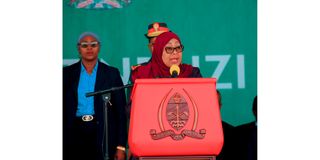Samia inaugurates Sh486bn fertiliser plant to revolutionise Tanzania's agriculture

President Samia Suluhu Hassan
What you need to know:
- President Samia Suluhu Hassan, alongside her Burundian counterpart, President Évariste Ndayishimiye, officially launched the Itracom Fertiliser Limited (IFL) facility at the Nala Industrial Area on June 28, 2025.
Dodoma. Tanzania’s ambition to become a leading agricultural hub in Africa gained momentum on Saturday, June 28, 2025, with the inauguration of a $180 million (Sh486 billion) fertiliser plant in Dodoma—an investment aimed at reducing import dependence and addressing persistent fertiliser shortages across the region.
President Samia Suluhu Hassan, alongside her Burundian counterpart, President Évariste Ndayishimiye, officially launched the Itracom Fertiliser Limited (IFL) facility at the Nala Industrial Area on June 28, 2025.
With a current annual production capacity of one million tonnes, the state-of-the-art plant is expected to triple its output in future phases.
“This is more than just a factory—it represents agricultural transformation and regional cooperation,” said President Hassan.
“Through this investment, we are creating opportunities for young people and strengthening the agricultural value chain,” she added.
For years, member states of the East African Community (EAC) have struggled with fertiliser shortages, driven by high import costs, global supply disruptions, and underdeveloped infrastructure.
These challenges have undermined food security and limited crop yields, particularly among smallholder farmers. With the launch of the Dodoma plant, the tide could be turning.
“Affordable access to fertiliser has long been a challenge for our farmers. This factory will help improve availability and affordability—not just for Tanzania, but for the entire region,” she added.
She urged the plant’s management to ensure nationwide distribution, particularly to rural areas, and to collaborate with research institutions and local authorities in training farmers on proper usage.
“Fertilisers must reach even the most remote villages. Work with extension officers to educate farmers and boost efficiency,” she emphasised.
Situated on 21 hectares, the plant currently employs 1,805 staff, with over 3,000 indirect jobs expected as operations scale up.
It is one of the largest fertiliser plants in the region, and President Hassan reiterated her government’s full support to ensure its success.
“I commend the investor for not only delivering on their commitment but also choosing agriculture—a safe and strategic sector—as their focus,” she added.
President Ndayishimiye described the project as a major milestone in regional integration and agricultural resilience.
“This plant reflects the deepening ties between Burundi and Tanzania. Access to sufficient and affordable fertiliser is key to increasing agricultural production and food security,” he said.
He noted that relations between the two countries date back to 1962, when they signed their first trade agreement.
“Today, Burundians are coming to Tanzania not as refugees, but as investors,” he said, expressing confidence that the facility would spur further regional investments, encouraging Tanzanian investors to explore opportunities in Burundi.
President Hassan used the occasion to highlight reforms and investments her administration has made in agriculture.
Since 2021, she said, the government has increased the agriculture budget by more than 300 percent—from Sh294 billion to Sh1.24 trillion.
“This has enabled us to address critical needs—access to quality seeds, irrigation, extension services, soil testing equipment, and market intelligence,” she said.
Despite this progress, she acknowledged that fertiliser access remained the sector’s biggest hurdle.
“That’s why we introduced the fertiliser subsidy programme. This factory complements those efforts and will drive higher productivity and better yields,” she said.
She reiterated agriculture’s role as the backbone of Tanzania’s economy, contributing about 70 percent of employment, 60 percent of industrial raw materials, 30 percent of Gross Domestic Product (GDP), and 25 percent of foreign exchange earnings.
With Africa’s population expected to double in 26 countries by 2050, she underscored the urgency of investing in sustainable food systems.
“Securing our agricultural future—including fertiliser production and usage—is essential. We must act now to meet the demands of tomorrow,” she said.
Earlier, Agriculture Minister Hussein Bashe assured stakeholders that the government would continue supporting cross-border fertiliser trade.
“The idea of reserving fertiliser solely for domestic use is outdated. We will meet national demand while also enabling exports. That’s the only way such investments can remain commercially viable,” he said when introducing the inauguration to Tanzanian journalists in Dodoma.
Mr Bashe also revealed that the government is finalising a national soil health map to support the production of customised fertiliser blends tailored to specific regional needs.
He said the Itracom plant had already procured 100,000 tonnes of manure from local livestock keepers, injecting Sh15 billion into rural economies.
“This plant is not only about fertiliser—it is generating new income streams for Tanzanians,” said Mr Bashe.
In the 2025/26 financial year, the government plans to procure 200,000 tonnes of fertiliser and 50,000 tonnes of lime for distribution under the fertiliser subsidy scheme, targeting areas with historically low fertiliser use.
The aim is to ensure that at least 80 percent of the fertiliser used is sourced locally.
He added that the government is in discussions with potential investors interested in producing urea, leveraging Tanzania’s coal reserves to expand domestic fertiliser manufacturing capacity.





